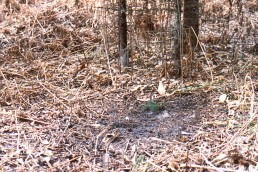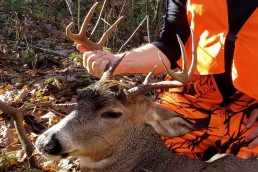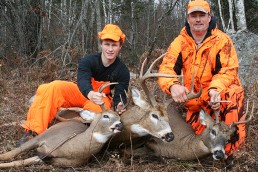Best Buck Stand Sites for October
SHARE THIS POST
Nowadays, when you walk down the aisles of your favorite sporting goods store, you will find hundreds of items intended for hunting whitetails during the later half of October. This month, bucks are making and regularly renewing ground scrapes. Aside from new archery equipment, camo clothing, portable stands and blinds, the one item that interests most whitetail hunters—especially bowhunters—now is a doe-in-heat buck lure (doe urine containing do-in-estrus pheromone).
Nothing purchased in a store today has a greater reputation for attracting antlered bucks. And 30-some years of widespread use of such a lure has created a new generation of American whitetails (when mature) that clearly recognize the danger of approaching a source of airborne doe-in-heat pheromone accompanied by fresh, airborne odors of a human hunter. This does not mean such a lure is no longer effective. It only means it must be used with great care to avoid mixing its downwind scent with fresh human odors.
One of the most likely productive buck stand sites of the year, if hunted properly, is the site of a “freshly made” or “renewed” ground scrape. Freshly made or renewed are descriptions of sites that determine whether or not a buck ground scrape has a chance of being productive.
Aren’t they all freshly made or renewed?
Well, yes, initially, but after a few days there will be lots of abandoned ground scrapes that have no chance of being productive—even those reeking with store-bought, doe-in-heat pheromone.
This second phase of the whitetail rut (the breeding range establishment phase) is generally triggered when a certain low temperature at night occurs and becomes the average low in mid-October: low temperatures of 32 degrees in Minnesota and most northern states, etc., and average lows in the 60s in South Carolina and other adjacent southern states. (These temps are usually 2–3 weeks before breeding begins.) At this point all antlered buck in the woods, including yearling bucks, begin marking intended breeding ranges with easily spotted, musk-laden signposts—antler rubs and ground scrapes. Typically within 3 to 7 days, the most dominant of these bucks—one that has already conquered all other bucks living within its one- or two-square-mile home range in battle—will rid its range (now a breeding range) of all competition, except for yearling bucks determined to stay near their mothers.
From this time until the primary breeding phase of the rut is over, this buck will be busy keeping other bucks from returning to their home ranges prematurely. One way to keep lesser bucks from returning early is to renew the appearance and musk odors of each of their rubs and dozens of scrapes once every 24 to 48 hours—a no trespassing sign for lesser bucks. Meanwhile, all those scrapes made by the bucks lower in their square-mile-buck pecking order are abandoned, losing their appearance of being freshly made or renewed.
The trouble is there are other reasons why scrapes made by dominant breeding bucks are abandoned—abnormally warm temperatures, for one. While the temperature is above 40 degrees, northern bucks, with their new growth of winter fur, are unlikely to exert themselves by making or renewing ground scrapes until normal temperatures resume. Strong winds and stormy weather can also cause temporary halts. But the most common of reasons, unfortunately, is hunting.
When stand-hunting near a scrape made by a dominant breeding buck, you are up against one of the world’s most elusive big game, a buck that has achieved its advanced age and size by being superior in cunning and in identifying and avoiding human hunters. This is an animal that knows it is dangerous to approach a source of doe-in-heat pheromone accompanied by fresh human odors. You are dealing with an animal with a nose estimated to be 10,000 times more sensitive than a human nose. It is capable of knowing which direction a human has traveled by noting minute differences in trail scents from rubbery-smelling boot track to rubbery-smelling boot track.
Are you enjoying this post?
You can be among the first to get the latest info on where to go, what to use and how to use it!
Now consider these questions: Do you believe your trail scents, including those you deposited about a nearby ground scrape, magically disappear the moment you sit down on the seat of your treestand? Do you believe your breath, hair, boots, hunting equipment and hands are odorless?
Nothing attracts a dominant buck to a scrape better than its own scrape, especially if untainted by human odors.

The reasons mentioned above are going to keep a dominant buck from regularly renewing the appearance and musk odors of its own scrape. The more you do to try to improve your chances of seeing a mature buck approach its own ground scrape—using a call, rattling antlers or adding a lure scent, while depositing fresh human scents in the process—the less likely it becomes that you will see any buck. They will abandon it, almost always occurring without a hunter’s knowledge.
Therefore, when hunting near a freshly made or renewed ground scrape, don’t approach within 15 to 20 yards of it. Also, don’t approach within 100 to 200 yards in either direction. Sit downwind or not “too close” crosswind, remaining very quiet, only moving a little, and then very slowly. Wear your camo headnet and gloves and be very patient. When the buck suddenly appears, be sure not to move while either or both of its eyes are in sight.
My 30-plus years of experimenting with lure scents has taught me not only the best way, but also where to use a doe-in-heat lure scent: a crosswind setup upwind of a current, favorite whitetail feeding area. Wear brand new rubber gloves, and place 10 to 20 sources of scent, untainted by human odors at ground level 10 to 13 paces apart along a fairly straight-line crosswind. Waste no time getting settled at your stand site—one located 20 yards crosswind of your final scent source if bowhunting, or 50 yards crosswind if gun hunting—facing your end of your line of scent sources. You do not need to be in sight of all your scent sources, only the last two to three. Your odors will eventually spread into your side of the huge downwind area where your pheromone is spreading. Most of the area downwind of your farthest scent sources will not be tainted by your odors. Antlered bucks, downwind of that section that are not accompanying does in heat, will be attracted to your unseen scent sources, after which, most will begin traveling from scent source to scent source until within easy shooting range of your stand site. No matter where a buck is in your crosswind line of scent sources, it will not be able to smell you, even when only 20 yards away.
If your line of scent sources is 100 to 200 yards upwind and parallel to an area or trail currently frequented by whitetails—and you avoid using other types of lures in an attempt to improve your odds for success—your odds of attracting a buck to within easy shooting range will be as good as they can be today.
Dr. Ken Nordberg has written more than 700 magazine articles and 12 books on the habits and hunting of whitetails and black bears, including the Whitetail Hunters Almanac series. He also produced Doc’s Buck and Bear Hunting School videos. His encyclopedic website is at drnordbergondeerhunting.com.
MWO
SHARE THIS POST
Did you enjoy this post?
You can be among the first to get the latest info on where to go, what to use and how to use it!



